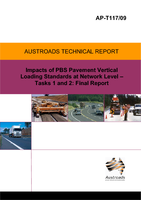Asset Management

Impacts of PBS Pavement Vertical Loading Standards at Network Level Tasks 1 and 2: Final report
- Publication no: AP-T117-09
- ISBN: 978-1-921551-03-1
- Published: 27 January 2009
- PDF (free) Download
The economic and functional impacts of PBS PVLS were quantified at network level using a life cycle costing approach. The assessment involved comparative analysis of the changes in agency and user costs associated with a number of scenarios with a base case. The base case included the current fleet, operating under GML and related pavement loading. The scenarios included different combinations of PBS vehicles with different take-up rates and their associated pavement loading. In developing the scenarios, it was assumed that the new PBS fleet will perform the same transport task as the current fleet it is replacing. Growth in freight task was applied for the base case and the scenarios. The assessment results indicated that the PBS PVLS requires further assessment to limit the overall wear caused by vehicles converting for volume gain and operating fully laden under PBS.
- AP-T117/09 Impacts of PBS Pavement Vertical Loading Standards at Network Level – Tasks 1 and 2: Final Report
- SUMMARY
- CONTENTS
- TABLES
- FIGURES
- 1. INTRODUCTION
- 1.1. PBS Pavement Vertical Loading Standard (PVLS)
- 1.2. Aim
- 1.3. Economic Impacts of PBS PVLS at Network Level
- 2. ASSESSMENT APPROACH
- 2.1. Assessment Needs
- 2.2. Assessment Process
- 2.3. Assumptions
- 3. PILOT NATIONAL COMPOSITE NETWORK
- 4. HEAVY VEHICLE FLEET
- 4.1. Current Fleet
- 4.2. Future Fleet
- 5. PAVEMENT WEAR
- 5.1. Pavement Wear Caused by Individual Vehicles
- 5.2. Annual Number of Vehicles
- 5.3. Annual Pavement Wear on each Section of the Network
- 5.4. Fleet Distribution and Growth
- 5.5. Growth Rates for Number of Vehicles and ASAR
- 6. FLEET AND LOADING SCENARIOS
- 6.1. Base Cases
- 6.2. Conversion to PBS
- 6.3. Migration Under PBS
- 6.4. Migration Under GML
- 6.5. Mass Limit Increase
- 6.6. Impact of Scenarios on Wear of Different Pavement Types
- 7. IMPACTS OF SCENARIOS ON AGENCY COSTS
- 7.1. PLCC Analysis
- 7.2. Approach for Assessing Impacts of Scenarios on Agency Costs
- 7.3. Results
- 7.4. Discussion
- 7.5. Impacts on Agency Costs by Pavement Type
- 8. IMPACTS OF SCENARIOS ON ROAD USER COSTS
- 8.1. PLCC RUC Models
- 8.2. Impacts of Scenarios on RUC
- 8.3. Discussion
- 8.4. Disaggregating Road User Savings
- 9. PBS ENVIRONMENTAL AND SAFETY IMPACTS
- 9.1. Definition of Environmental and Safety Impacts
- 9.2. Environmental Impacts of PBS
- 9.3. Safety Implications of PBS
- 9.4. Congestion
- 9.5. Summary
- 10. ECONOMIC EVALUATION
- 10.1. Net Benefits of Loading Scenarios
- 10.2. Impacts of Higher Roughness Progression Rates
- 10.3. Impacts of Constrained Agency Budget
- 10.4. Agency Unit Costs by Road Section
- 11. CONCLUSIONS
- REFERENCES
- APPENDIX A PBS PAVEMENT VERTICAL LOADING STANDARD
- APPENDIX B DEVELOPMENT OF THE COMPOSITE NATIONAL ROAD NETWORK
- APPENDIX C CURRENT FLEET AND GTK
- APPENDIX D PROPOSED MAXIMUM AXLE LOADS AND GROSS MASSES FOR PBS VEHICLES
- APPENDIX E PAVEMENT WEAR CAUSED BY INDIVIDUAL VEHICLES
- APPENDIX F NUMBER OF VEHICLES USING THE NETWORK
- APPENDIX G LOADING SYSTEM
- APPENDIX H APPLICATION EXAMPLES FOR SCENARIOS
- APPENDIX I IMPACTS OF SCENARIOS ON PAVEMENT WEAR AND NUMBER OF VEHICLES
- APPENDIX J ARRB PAVEMENT LIFE CYCLE COSTING MODEL
- APPENDIX K MODIFIED PLCC ROAD USER COST MODELS
- APPENDIX L ENVIRONMENTAL AND SAFETY ISSUES
- INFORMATION RETRIEVAL
Related publications
WEB-PROJECTS-23
WEB-T367-70-23
Latest Asset Management News
